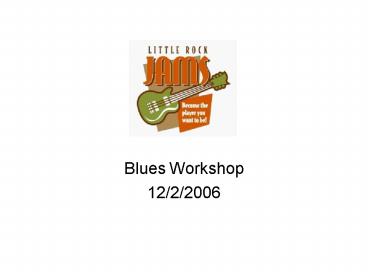Blues Workshop - PowerPoint PPT Presentation
1 / 9
Title:
Blues Workshop
Description:
Take the first (I), fourth (IV) and fifth (V) chords to build your progression. ... the guitar neck, you can use these chord grips for other roots (i.e. G7, Bb7, E7, ... – PowerPoint PPT presentation
Number of Views:312
Avg rating:3.0/5.0
Title: Blues Workshop
1
- Blues Workshop
- 12/2/2006
2
What is the Blues?
- The Blues, as a musical style, has different
meanings for different people Boogie, Texas,
Country, Rock, Delta, etc. - People can talk about the blues from a
theoretical standpoint (i.e. a 1-4-5 progression
over 8/12/16/24 bars, etc), but doing so misses
the point. - To quote Bill Dahl, The blues is as honest a
musical form as it is uplifting. The blues is
life with all its ups and downs intact
3
Blues Styles
4
Suggested Listening
5
Blues Progressions
- Start with knowing your major scale or build the
scale if you do not know the notes. - Step Pattern for Major Scale W W H W W W H
- Take the first (I), fourth (IV) and fifth (V)
chords to build your progression. - Example in the Key of A A B C D E F G A
- I A, IV D, V E
- While you can play the blues using major chords,
the norm is to use dominant chords. So, for all
three chords above, play them as seventh chords
(A7, D7, E7). - Typical blues progressions are 12 measures long,
aka 12 bar blues. There are 8 bar, 16 bar and 24
bar blues. For this workshop, well focus on 12
bar blues.
Basic 12 Bar Blues A7 / A7 / A7 / A7 D7 / D7 / A7
/ A7 E7 / D7 / A7 / A7
Quick Change Blues A7 / D7 / A7 / A7 D7 / D7 / A7
/ A7 E7 / D7 / A7 / E7
Jazz Blues A7 / D7 / A7 / Em7 A75 D7 / Ebdim /
A7 / A7 E7 / D7 / A7 / F7 E7
Basic 12 Bar Blues I7 / I7 / I7 / I7 IV7 / IV7 /
I7 / I7 V7 / IV7 / I7 / I7
Quick Change Blues I7 / IV7 / I7 / I7 IV7 / IV7 /
I7 / I7 V7 / IV7 / I7 / V7
Jazz Blues I7 / IV7 / I7 / vm7 I75 IV7 / bVdim /
I7 / I7 V7 / IV7 / I7 / V7 V7
6
Blues Progressions
- For minor blues, change the I and IV chords to
minor 7th and make the V chord an altered
dominant 7th (ex. D79). - The Blues can be played in any key, but the
common keys are A, E and G for Rock/Country blues
and F, Bb, Eb for Jazz blues. - Use of alternate tunings is also a common feature
in some blues. Alternate tunings such as open D
(D A D F A D) and open G (D G D G B D)
facilitates both finger style and slide
application.
Stormy Monday Blues G7 / C7 / G9 Ab9/ G7 C7 / C7
/ G9 Am7/ Bm7 Bbm7 Am7 / Cm7 / G7 C7/ G7 D
Stormy Monday Blues I7 / IV7 / I9 bII9/ I7 IV7 /
IV7 / I9 iim7/ iiim7 biiim7 iim7 / ivm7 / I7 IV7/
I7 V
Minor 12 Bar Blues w/a Quick Change Am7 / Dm7 /
Am7 / Am7 Dm7 / Dm7 / A7 / A7 E79 / Dm7 / Am7 /
E79
Minor 12 Bar Blues w/a Quick Change Im7 / IVm7 /
Im7 / Im7 IVm7 / IVm7 / I7 / I7 V7alt / IVm7 /
Im7 / V7alt
7
Blues Chords
- This is a sample of A dominant chords (7th,
9th, 13th) that may be used in a blues. As
always, learn several ways to play all chords. - Most of these chords are root position, meaning,
if you know the names of the notes on the guitar
neck, you can use these chord grips for other
roots (i.e. G7, Bb7, E7, D7, etc)
8
Blues Soloing
- Use of the pentatonic scale is the main soloing
device used in blues. To move freely around the
neck, you should learn all five patterns of the
pentatonic scale. - The flatted fifth (b5) interval in the minor
pentatonic scale is also known as the Blue
Note. Use of this interval is essential to
getting a true blues sound when soloing. - To solo expressively, once the pentatonic scale
is under your fingers, work in expression
techniques such as slides, octaves, bends, double
stops and vibrato. - Depending on the genre (i.e. jazz, rock, delta,
etc), you should also work on playing the notes
in both a straight 8th note or swing style. - Finally, playing a blues solo is more about
emotion and expression than how many notes you
play. While it is fun to play fast runs, to truly
sound like the blues, playing fewer notes more
expressively is the way to go!
9
Pentatonic Boxes
G minor pentatonic 13th fret
G minor pentatonic 8th fret
G minor pentatonic 3rd fret
G minor pentatonic 10th fret
G minor pentatonic 6rd fret
BLUE Notes the b5 note RED Notes the G root































